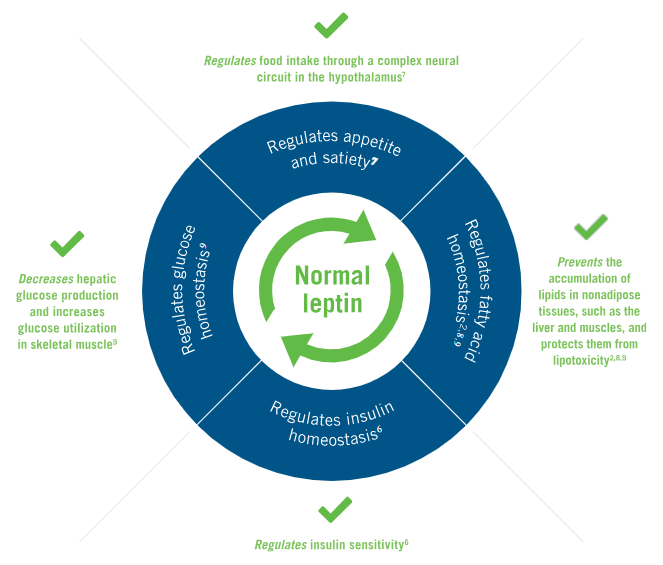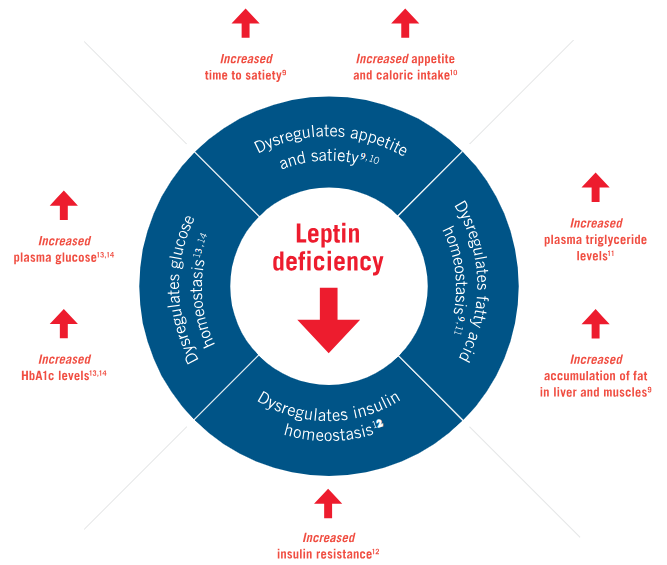Leptin deficiency in GL leads to metabolic complications.

Leptin deficiency in GL leads to metabolic complications.
GL and Leptin
Leptin deficiency is the key pathogenic pathway underlying severe metabolic abnormalities in generalized lipodystrophy (GL)—with potential life-threatening implications.1,2
In normal physiology, leptin acts in the brain and periphery to regulate energy homeostasis and metabolic function in the body4,6
Adipose tissue produces leptin, a key regulator of metabolic function.5

In GL, leptin deficiency leads to significant metabolic dysfunction.1,2
Metabolic abnormalities such as hyperphagia, insulin resistance, diabetes mellitus, and hypertriglyceridemia can lead to serious consequences in patients with GL.1,2

1. Handelsman Y, Oral EA, Bloomgarden ZT, et al. The clinical approach to the detection of lipodystrophy—an AACE consensus statement. EndocrPract. 2013;19(1):107-116.doi:10.4158/endp.19.1.v767575m65p5mr06. 2. Brown RJ, Araujo-Vilar D, Cheung PT, et al. The diagnosis and management of lipodystrophy syndromes: a multi-society practice guideline. J Clin Endocrinol Metab. 2016;101(12):4500-4511. doi:10.1210/jc.2016-2466. 3. Van Maldergem L, Magré J, Khallouf TE, et al. Genotype-phenotype relationships in Berardinelli-Seip congenital lipodystrophy. J Med Genet. 2002;39(10):722-733. doi:10.1136/jmg.39.10.722. 4. Kershaw EE, Flier JS. Adipose tissue as an endocrine organ. J Clin Endocrinol Metab. 2004;89(6): 2548-2556. doi:10.1210/jc.2004-0395. 5. Lago F, Dieguez C, Gómez-Reino J, Gualillo O. Adipokines as emerging mediators of immune response and inflammation. Nat Clin Pract Rheumatol. 2007;3(12):716-724. doi:10.1038/ncprheum0674. 6. Mantzoros CS, Magkos F, Brinkoetter M, et al. Leptin in human physiology and pathophysiology. Am J Physiol Endocrinol Metab. 2011;301(4):e567-e584. doi:10.1152/ ajpendo.00315.2011. 7. Kelesidis T, Kelesidis I, Chou S, Mantzoros CS. Narrative review:the role of leptin in human physiology: emerging clinical applications. Ann Intern Med. 2010;152(2):93-100. doi:10.1059/0003- 4819-152-2-201001190-00008. 8. Unger RH, OrciL. Lipoapoptosis: its mechanism and its diseases. BiochimBiophys Acta. 2002;1585(2-3):202-212. doi:10.1016/S1388-1981(02)00342-6. 9. Fiorenza CG, Chou SH, MantzorosCS. Lipodystrophy: pathophysiology and advances in treatment. Nat Rev Endocrinol. 2011;7(3):137-150. doi:10.1038/nrendo.2010.199. 10. Huang-Doran I, Sleigh A, Rochford JJ,O’Rahilly S, Savage DB. Lipodystrophy: metabolic insights from a rare disorder. J Endocrinol. 2010;207(3):245-255. doi:10.1677/JOE-10-0272. 11. Ginsberg HN. Insulin resistance and cardiovascular disease. J Clin Invest. 2000;106(4):453-458. doi:10.1172/JCI10762. 12. Garg A. Acquired and inherited lipodystrophies. N Engl J Med. 2004;350(12):1220-1234. doi:10.1056/NEJMra025261. 13. Ferraria N, Pedrosa C, Amaral D, Lopes L. Berardinelli-Seip syndrome: highlight of treatment challenge [published online January 28,2013]. BMJ Case Rep. 2013. doi:10.1136/bcr-2012-007734. 14. Diabetes mellitus. Merck Manuals website. https://www.merckmanuals.com/professional/endocrine_and_metabolic_disorders/diabetes_mellitus_and_disorders_of_carbohydrate_metabolism/diabetes_mellitus_dm.html?qt=HbA1c&alt=sh .Updated June 2014. Accessed March 3, 2017.

